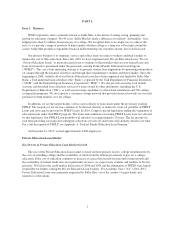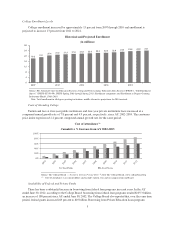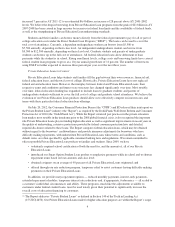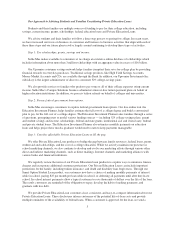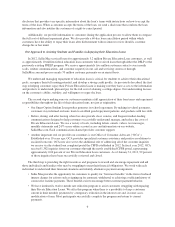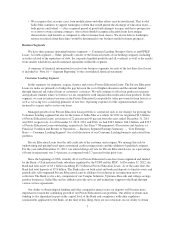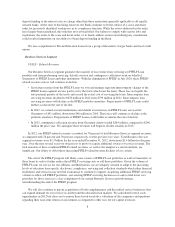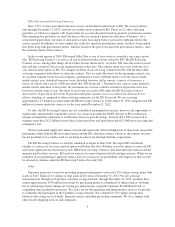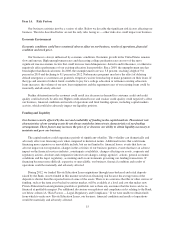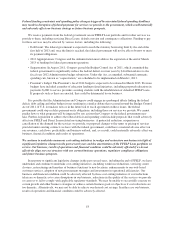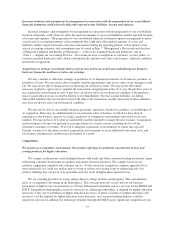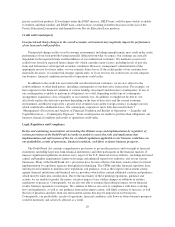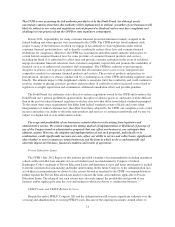Sallie Mae 2012 Annual Report Download - page 14
Download and view the complete annual report
Please find page 14 of the 2012 Sallie Mae annual report below. You can navigate through the pages in the report by either clicking on the pages listed below, or by using the keyword search tool below to find specific information within the annual report.principal collected so as to be more in conformance with federal education loan programs could significantly and
materially affect the way in which we choose to do business and the profitability of our business. The CFPB’s
focus on the concerns of students extends beyond the terms and conditions of Private Education Loans and
includes the following:
• The Dodd-Frank Act created a Private Education Loan Ombudsman within the CFPB to receive and
attempt to informally resolve inquiries about Private Education Loans. The Private Education Loan
Ombudsman reports to Congress annually on the trends and issues that it identifies through this process.
On October 16, 2012, the Ombudsman submitted its first report based on 2,900 inquiries, finding that
borrowers tended to report problems with their loan servicing and repayment options. The report draws
conclusions about problems in education loan servicing and suggests Congress consider further steps to
provide loan modifications or refinancing opportunities for troubled borrowers. Most of the inquiries that
we have received from customers via the CFPB process are made by borrowers facing difficulty in
repayment due to unemployment and underemployment due to the faltering economy.
• The CFPB is also particularly focused on interactions between prospective students and the financial aid
offices of colleges and universities, and the quality and accuracy of the information students are being
provided through financial aid offices. The CFPB announced on January 31, 2013 that it is seeking
information on the financial products and services offered to students through colleges and universities,
including products marketed through campus affinity relationships, such as financial aid disbursement
accounts, student banking, prepaid cards and credit cards. The deadline for submission of information to
the CFPB is March 18, 2013. It is likely this inquiry, much like prior inquiries with respect to credit
cards, and other financial products, will lead to the issuance of a report and recommendations or proposed
regulatory changes related to the issuance and utilization of these products. If so, several of our
businesses could be affected.
• The CFPB announced on February 21, 2013 that it is seeking information on options available to
borrowers having difficulty repaying their loans. The deadline for submission of information to the CFPB
is April 8, 2013. For a discussion on our approach to helping customers, see Item 1 “Business — Our
Approach to Assisting Students and Families in Repaying their Education Loans.”
Debt Collection Supervision. On October 24, 2012, the CFPB issued its final debt collection larger
participant rule and examination procedures that will allow the agency to federally supervise larger consumer
debt collectors. The rule defines larger participants as third-party debt collectors, debt buyers, and collection
attorneys with more than $10 million in annual receipts resulting from consumer debt collection. Under the rule,
our collection subsidiaries are considered larger participants and will be subject to supervision. The rule became
effective January 2, 2013. The issuance of the CFPB’s rules will not preempt the various and varied levels of
state consumer and collection regulations to which the activities of our subsidiaries are currently subject. We also
utilize third-party debt collectors to collect certain defaulted and charged-off education loans. We will continue
to be responsible for oversight of their procedures and controls.
Evolving Regulation of the Bank. As of December 31, 2012, the Bank had assets of $9.1 billion. We expect
its assets to exceed $10 billion by the third or fourth quarter of 2013. Based on current estimates, we expect the
Bank will eventually be designated as a “large bank” under the Dodd-Frank Act and be subject to additional
regulatory requirements. For example, once the Bank has four consecutive quarters with assets of at least $10
billion, the CFPB will become the Bank’s primary compliance supervisor. The UDFI and FDIC will remain the
prudential regulatory authorities with respect to the Bank’s financial strength. However, once the Bank’s average
assets over any four quarter period are at least $10 billion, it will subsequently become subject to annual stress
testing requirements. Furthermore, the Dodd-Frank Act imposed a moratorium on the further creation of, and
strictly limited the transfer of, industrial banks such as the Bank. This moratorium will expire in the summer of
2013. At this time we do not expect significant changes with regard to the form or regulation of industrial banks
or their exclusion from federal bank holding company regulation, but we cannot predict the nature or actions that
Congress or federal banking authorities might choose to take with regard to the industrial bank exclusion.
12


